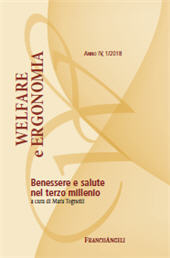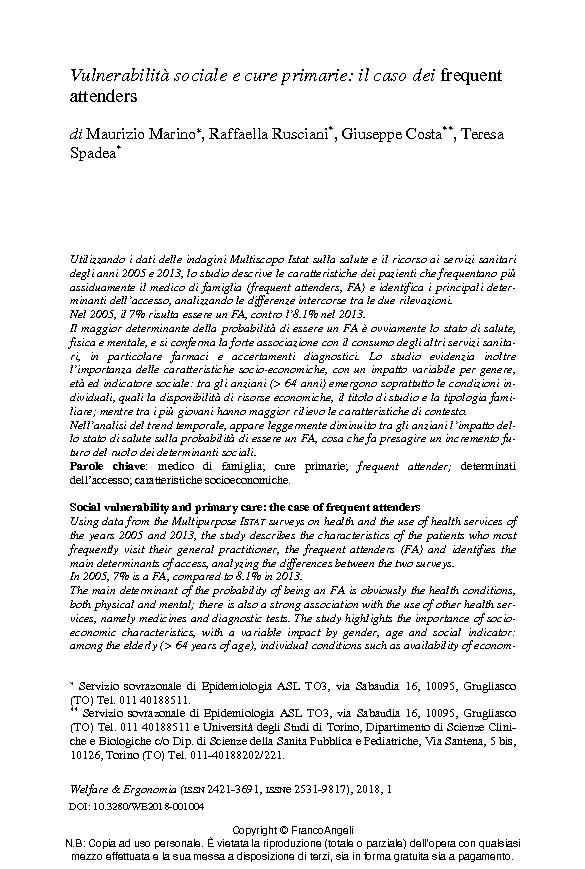2018 - Franco Angeli
Artículo
Digital Version
Download | Copia/pega | Impresión
Vulnerabilità sociale e cure primarie : il caso dei frequent attenders
73-85 p.
- Utilizzando i dati delle indagini Multiscopo Istat sulla salute e il ricorso ai servizi sanitari degli anni 2005 e 2013, lo studio descrive le caratteristiche dei pazienti che frequentano più assiduamente il medico di famiglia (frequent attenders, FA) e identifica i principali determi-anti dell'accesso, analizzando le differenze intercorse tra le due rilevazioni. Nel 2005, il 7% risulta essere un FA, contro l'8.1% nel 2013. Il maggior determinante della probabilità di essere un FA è ovviamente lo stato di salute, fisica e mentale, e si conferma la forte associazione con il consumo degli altri servizi sanitari, in particolare farmaci e accertamenti diagnostici. Lo studio evidenzia inoltre l'importanza delle caratteristiche socio-economiche, con un impatto variabile per genere, età ed indicatore sociale: tra gli anziani (> 64 anni) emergono soprattutto le condizioni individuali, quali la disponibilità di risorse economiche, il titolo di studio e la tipologia familiare;
- mentre tra i più giovani hanno maggior rilievo le caratteristiche di contesto. Nell'analisi del trend temporale, appare leggermente diminuito tra gli anziani l'impatto dello stato di salute sulla probabilità di essere un FA, cosa che fa presagire un incremento futuro del ruolo dei determinanti sociali. [Testo dell'editore].
- Using data from the Multipurpose ISTAT surveys on health and the use of health services of the years 2005 and 2013, the study describes the characteristics of the patients who most frequently visit their general practitioner, the frequent attenders (FA) and identifies the main determinants of access, analyzing the differences between the two surveys. In 2005, 7% is a FA, compared to 8.1% in 2013. The main determinant of the probability of being an FA is obviously the health conditions, both physical and mental; there is also a strong association with the use of other health services, namely medicines and diagnostic tests. The study highlights the importance of socio-economic characteristics, with a variable impact by gender, age and social indicator: among the elderly (> 64 years of age), individual conditions such as availability of economic resources, education and family type have the strongest impact; while among the younger ones, contextual characteristics are more relevant.
- In the analysis of the temporal trend, the impact of the health conditions on the probability of being a FA appears slightly diminished among the elderly, which suggests a future increase in the role of social determinants. [Publisher's text].
Forma parte de
Welfare e ergonomia : IV, 1, 2018-
Información
Código DOI: 10.3280/WE2018-001004
ISSN: 2531-9817
KEYWORDS
- Medico di famiglia, cure primarie, frequent attender, determinati dell'accesso, caratteristiche socioeconomiche
- General practitioner, primary care, frequent attenders, determinants of access, socioeconomic characteristics
-
En el mismo archivo
- Introduzione
- Determinanti globali della salute e (in)sostenibilità dell'obiettivo di copertura sanitaria universale
- Le politiche regionali verso le disuguaglianze di salute
- Vulnerabilità sociale e cure primarie : il caso dei frequent attenders
- Come adeguare la malattia all'esistenza : l'esperienza delle malattie croniche durante l'infanzia
- La digitalizzazione dei processi organizzativi in sanità : il caso della gestione dei farmaci oncologici
- Dalla Sindrome di Yentl alla medicina di genere : una sfida per la ricerca scientifica
- La medicina di genere : il contributo della ricerca di base per lo studio delle differenze tra uomini e donne
- Rischio cardiovascolare : diversità tra uomini e donne
- L'epidemiologia dei tumori : un'ottica di genere dalla prevenzione alle cure di fine vita



